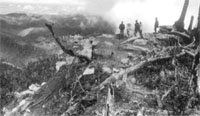Edged to extinction
 rainforests are one of the most severely threatened ecosystems on Earth today. Every passing year sees ambitious plans drawn up to prevent them from further degradation or preserve whatever little of them might be left. A new study, however, says that small patches of these forests may not be worth saving.
rainforests are one of the most severely threatened ecosystems on Earth today. Every passing year sees ambitious plans drawn up to prevent them from further degradation or preserve whatever little of them might be left. A new study, however, says that small patches of these forests may not be worth saving.
Conservation in many parts of the tropics usually relies on preserving fragments of forest left over after farmers have cleared off the rest. Such efforts, however, may be wasted on areas of 100 hectares (ha) or less, which the recently-conducted research suggests are too small to remain as self-regenerating ecosystems.
Julieta Benitez-Malvido of the National University of Mexico studied 11 fragments of forest ranging in size from 1 to 100 ha near Manaus, Brazil.She found that the density of shade-tolerant seedlings - which represent the majority of trees - decreases dramatically towards the forest edge, and is up to 40 per cent less in the corners of a fragment than in the centre. She concludes that below a certain size, rainforest segments cannot contain enough seedlings to fully regenerate plant species within them (Conservation Biology, Vol 12, p 380).
"When I started the project, I thought seedling density would be higher closer to the forest edges, as the edges are lighter," says Benitez-Malvido. In fact, the opposite was true. One of the key factors was the change in climate within the forest, with a hotter, drier environment near the edges preventing germination of the shade-tolerant species that have higher growth rates.
The reduced number of animal species in small forest sections is also an important factor. More than 80 per cent of tropical trees are usually pollinated by the animals, which also help to disperse the seeds and fruits. Fig trees, for instance, are pollinated by wasps and their seeds dispersed by bats, rodents, monkeys, iguanas and even ants. Fewer primates, birds and other animals means there is less "seed rain" - seed dispersed in faeces.
Benitez-Malvido concludes that even 100-ha fragments do not nurture enough seedlings to be self-sustaining. However, she admits that preserving fragments of 100 ha or less may be the only option available in some areas. "At least these fragments can serve as germplasm pools for many animals and plants," she says. "We need to learn how to manage these patches and preserve them, and if possible, increase their area."
Related Content
- Scimitar-horned oryx return to the Sahara nearly two decades after going extinct in the wild
- Conservation group demands U.S. restore grizzly bears to native range
- Around 200 endemic plants of Sri Lanka threatened with extinction
- Severe loss of suitable climatic conditions for marsupial species in Brazil: Challenges and opportunities for conservation
- Over 30 Yangtze porpoises found dead in China as population nears extinction
- Court tells DDA to restore Neela Hauz by February 2013
